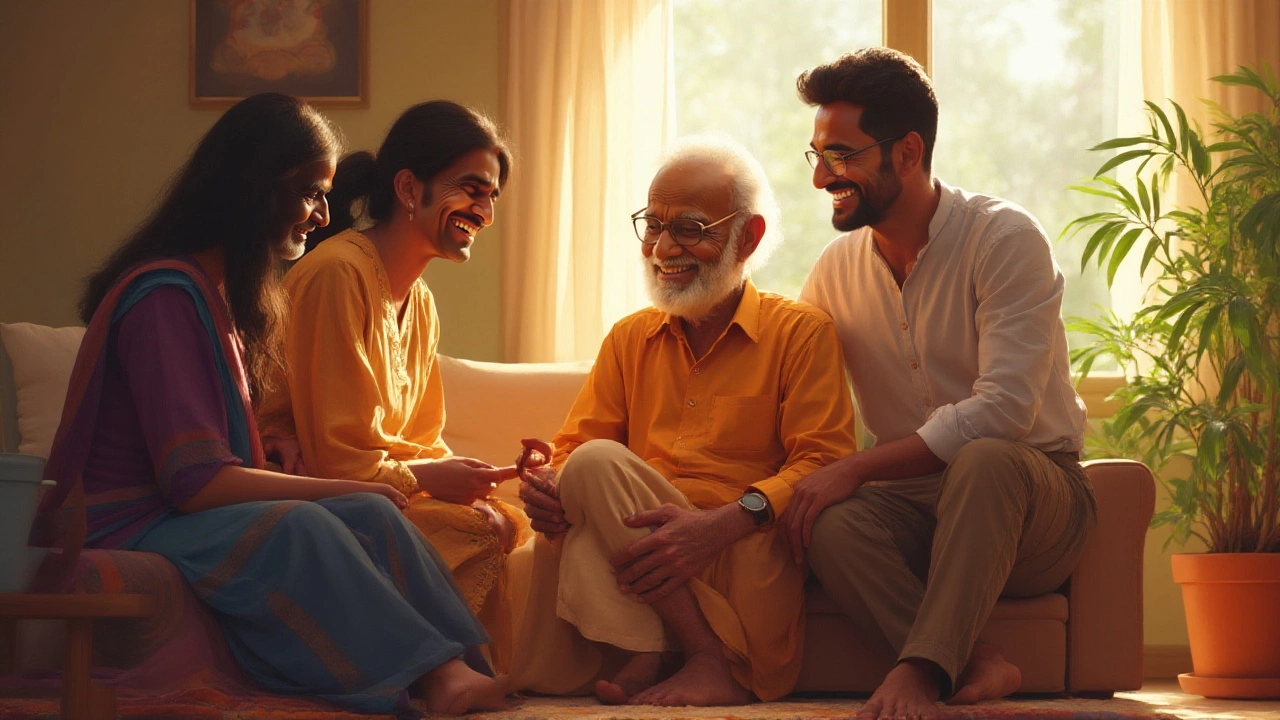
- Aug, 2 2025
- 0
Imagine thinking you’ve made it—the long, painful wait for knee replacement is behind you, the bandages are off, and the worst is over. But instead of joy, frustration sets in. Over half of all knee replacement patients talk about the same nagging issue post-surgery: they still can’t bend or straighten the knee fully like they hoped. It’s not sharp pain from a botched surgery or the shock of a swollen knee (though those happen too). It’s joint stiffness, that frustrating tightness that lingers month after month despite physio, exercise, and every home remedy you can dig up.
Why Does Stiffness Happen After Knee Replacement?
Knee implants are marvels of engineering, but they don’t replace the living tissue your body once had. After surgery, many people expect to walk pain-free, climb stairs, even squat—just like before arthritis hit. But stiffness is common. Nearly 20% of patients report bothersome stiffness that limits their activities. That’s a huge number—imagine two out of ten friends in a room, all wishing they could flex their new knees a little more.
Here’s why this happens: surgery itself is trauma, even when planned and expertly executed. Healing tissues often form scar tissue both inside and outside the joint, a process called arthrofibrosis. If swelling lingers, or if you don’t move the joint enough right after surgery, the tissues tighten and ‘stick’—think of a thick rubber band left in the sun too long. Adhesions stop your new knee from moving smoothly, and the more time passes, the harder it is to fix. The risk is even higher if you already had limited range of motion before getting surgery.
Other factors make patients more prone to stiffness, like being over 65, female, having diabetes, or being overweight. I still remember talking to a man at the park in early March, limping despite having had his operation six months ago. He told me he thought his knee would be a "miracle cure," but didn’t realize just how much work was needed to keep scar tissue from locking the joint.
Day-to-Day Life with a Stiff Knee
This isn’t just a small annoyance. Stiffness means basic things become difficult—tying shoes, sitting cross-legged on the floor to play with grandkids, getting into a car. For my dad, even getting in and out of bed in winter became a chore he dreaded. Many people say things like, "I thought knee replacement would give me my life back. I didn’t expect to still struggle doing stairs." But it’s not just physical—the mental toll is huge. People feel let down after hoping for a transformation. Guilt creeps in (“didn’t I do the exercises right?”) and anxiety takes over (“what if it stays like this forever?”).
Some folks push too hard, thinking more pain equals better results, but that backfires—excessive force leads to swelling, which means more stiffness. Others avoid movement entirely because they’re scared of damaging their new knee implant, which is equally bad. In reality, neither extreme works. Regular, gentle movement is the sweet spot.
Knee pain after surgery does go down in most cases, but getting rid of stiffness requires steady commitment. And timelines are not clear-cut: while some people feel much better after 3 or 6 months, others need an entire year. Some studies published in 2021 found that at 12 months post-surgery, about 12% of knee replacement patients still have “moderate to severe” stiffness that interrupts daily living (see table below). That’s one out of every eight patients.
| Time After Surgery | % with Moderate/Severe Stiffness |
|---|---|
| 1 Month | 45% |
| 3 Months | 25% |
| 6 Months | 15% |
| 12 Months | 12% |
Sometimes, when I bring up recovery tips to friends or neighbors, they’re surprised to learn that even something as simple as sleeping with the knee in a slightly bent position night after night can actually slow down the process. Or, how avoiding the exercises just for a week due to a family trip can set back progress for a month or longer. Small things add up over time.

Tips to Keep Stiffness Away and Improve Knee Flexibility
- Start movement early: Gentle bending and straightening exercises, typically within 24 hours post-surgery, are key. Hospitals now push for "enhanced recovery." The sooner you start moving the joint safely, the lower your risk of long-term stiffness.
- Stick to your physiotherapy routine: I know it’s tempting to skip those boring stretches—but missing sessions can double your risk of poor flexibility. Find a physical therapist who listens, adjusts the plan to your specific needs, and helps you troubleshoot if things aren't going right.
- Don’t overdo it: Yes, effort is important. But if you’re pushing yourself to the point of swelling, you’re crossing into the danger zone. Swelling leads to even more stiffness. Aim for "challenging but not exhausting" every session.
- Hydrate and fuel your body: It sounds too simple, but dehydration can slow healing, tighten tissues, and worsen cramps. Protein and vitamin C help tissue repair.
- Ice packs and elevation: The old classics still work. If your knee feels like a swollen balloon, ice for 15 minutes several times a day. Elevate the knee so it’s above your heart, especially in the evening.
- Keep realistic goals: If you had very limited knee motion before the operation, don’t expect to do yoga splits three months after surgery. But never settle for "just enough." Your therapists and doctors can often help you go further if you ask for more tips tailored to your life.
- Stay patient, but proactive: If after 3-4 months you’re still nowhere near 90 degrees of bend, or can’t straighten the knee at all, don’t wait. Talk to your surgeon. Sometimes, a controlled “manipulation under anesthesia” (MUA) helps break up tough scar tissue. The earlier, the better.
- Use adaptive devices if needed: Raised toilet seats, shoehorns, or car seat wedges can make daily life easier while you push your knee to gain more motion.
At home, setting timers to stretch every few hours worked wonders for my uncle—he taped reminders on the fridge. Group exercise, like water aerobics, helps too, since water supports the joint and allows for pain-free movement. And if you live with family, ask them to join you for walks; having someone around keeps you accountable.
Real Stories and Facts: Is It All Worth It?
It’s easy to get bogged down thinking about worst-case scenarios—chronic stiffness that never goes away, or another surgery needed to break up scar tissue. But here’s the part many people overlook: most knee replacement patients end up happier, healthier, and far more mobile than before. A 2022 multicenter survey in India of over 5,000 patients found that while 1 in 8 people do experience moderate to severe stiffness one year post-op, nearly 85% report much better pain relief, improved walking, and increased participation in daily life.
The number one thing that helps? Persistent, guided rehab—not just for weeks, but for months. And support from family. My wife, Esha, always encouraged her aunt to keep up her physio despite setbacks. My own kids, Anika and Vihaan, sometimes make "therapy a game," setting a timer and cheering every time their grandmother hit a new milestone. Sometimes, these small gestures are the biggest difference-makers over time.
If you’re reading this before having surgery, one tip: ask your surgeon about their approach to post-surgical physiotherapy. Some hospitals have in-house programs that check in weeks after you go home—it makes a difference. Research also shows that pre-surgery "prehabilitation" (building strength and flexibility before the operation) can cut your risk of long-term stiffness by half.
If you’re someone who’s stuck at 90 degrees of bending or less at three months, don’t panic. Speak up, get a review, and see if you’re a candidate for an MUA or more aggressive therapy. Pain doesn’t always mean you’re harming the knee, but swelling and persistent heat should prompt a checkup to rule out infection.
The biggest lesson I’ve seen among family and friends? Knee replacement is more of a marathon than a sprint. Keeping expectations real, staying stubbornly optimistic, and reaching out for help when needed—these are the traits that pay off, both physically and mentally.
Nikhil Verma
I'm a dedicated physician with a passion for exploring the intricacies of medicine, focusing on the unique healthcare challenges in India. I spend much of my spare time writing articles aimed at improving public understanding of health issues. Balancing my clinical practice and writing allows me to reach a wider audience, sharing insights and fostering a deeper appreciation for medical advancements. I derive immense satisfaction from both treating patients and engaging with readers through my writing.